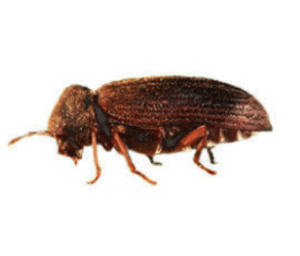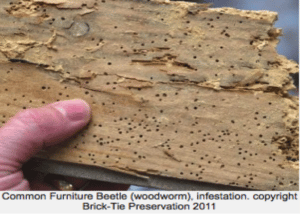Wood damaging pests can attack expensive antiques and even structural components of a building.
Much of the damage caused by wood boring beetles may be attributed to the Common Furniture beetle. Its natural habitat is the broken branches of trees and areas where the tree bark has been removed.

Appearance
Adult beetle is 3-4mm in length
Life Cycle
Larva will live for three to five years before boring through timber to breed.
Habits
- They actively fly in warm sunny weather.
- Is an exceedingly common pest in homes and buildings.
- Despite its name this beetle can invade more than just furniture.
- Infestations can damage decorative woodwork, musical instruments, wooden tools and more seriously, wooden flooring, joinery and structural timbers
- These wood boring beetles consume hardwoods and softwoods.
 How to identify signs of Wood Borer
How to identify signs of Wood Borer
One may not realise that one has a wood borer problem until the resulting damage becomes visible, so early detection is key before more harm is done.
What does a Wood Borer look like? There are four stages of wood borer development:
- Egg
- Larva
- Pupa
- Adult beetle
Adult beetles lay their eggs in cracks in wooden objects, floorboards and timbers.
When larvae hatch they immediately burrow through the timber, making it very unlikely they would be seen. As newborns they are hungry and your woodwork will be their only food source. Safely inside the wood, they will continue to tunnel and feed for several years.
As the larvae mature and increase in size, they bore towards the wood surface to pupate and emerge as adult beetles.
Fact: Different woodworm insects prefer different woods, which will help you to identify what type is causing your problems. Some prefer softwoods like pine, spruce and cedar while others like hardwoods such as eucalypt, oak, ash, and mahogany. Whatever the species, all of them will leave some signs, if you have an active wood borer infestation.
Signs of Wood Borer
- Fresh exit holes in timber – round or oval shaped with sharp edges, the holes will appear clean and fresh.
- Tunnels in the wood – also known as “galleries” which are often hard to see.
- Bore dust – (also known as frass) caused by emerging adult beetles, and are usually visible below the infested timber.
- Weak and damaged floorboards – in extreme cases, a foot or chair leg going through the floor can indicate a more serious problem.
- Crumbling wood – around corners or edges to roof joists or floorboards.
- Dead beetles – usually found near the infested timber or around nearby windowsills.
- Eggs – These vary in size depending on the beetle, but all are very difficult to see with the naked eye.
- Wood Borer larvae – usually a creamy-white colour and curved in shape.
Dealing with a Wood Borer infestation
If left untreated, wood borers can seriously weaken timber, which may lead to structural failure of timbers.
If you suspect any infestation, consult with our professional and registered inspector to give you a detailed report.
Contact: Nick Buxton : 082 727 1427
